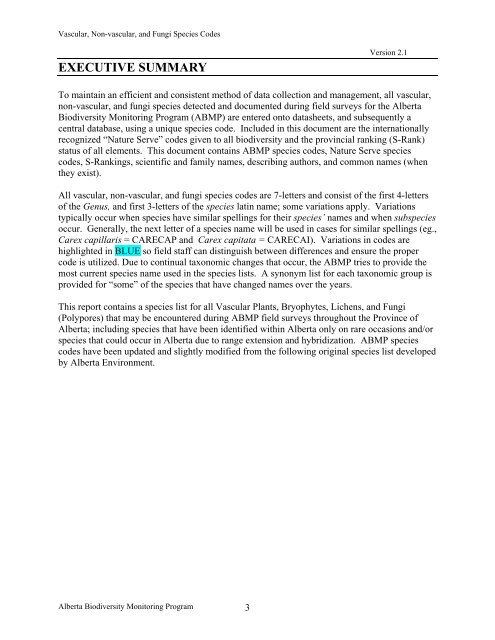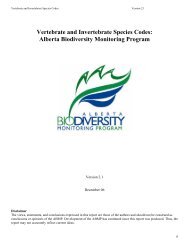Vascular Plants, Non-vascular Plants, and Fungi - Alberta ...
Vascular Plants, Non-vascular Plants, and Fungi - Alberta ...
Vascular Plants, Non-vascular Plants, and Fungi - Alberta ...
Create successful ePaper yourself
Turn your PDF publications into a flip-book with our unique Google optimized e-Paper software.
<strong>Vascular</strong>, <strong>Non</strong>-<strong>vascular</strong>, <strong>and</strong> <strong>Fungi</strong> Species Codes<br />
EXECUTIVE SUMMARY<br />
<strong>Alberta</strong> Biodiversity Monitoring Program 3<br />
Version 2.1<br />
To maintain an efficient <strong>and</strong> consistent method of data collection <strong>and</strong> management, all <strong>vascular</strong>,<br />
non-<strong>vascular</strong>, <strong>and</strong> fungi species detected <strong>and</strong> documented during field surveys for the <strong>Alberta</strong><br />
Biodiversity Monitoring Program (ABMP) are entered onto datasheets, <strong>and</strong> subsequently a<br />
central database, using a unique species code. Included in this document are the internationally<br />
recognized “Nature Serve” codes given to all biodiversity <strong>and</strong> the provincial ranking (S-Rank)<br />
status of all elements. This document contains ABMP species codes, Nature Serve species<br />
codes, S-Rankings, scientific <strong>and</strong> family names, describing authors, <strong>and</strong> common names (when<br />
they exist).<br />
All <strong>vascular</strong>, non-<strong>vascular</strong>, <strong>and</strong> fungi species codes are 7-letters <strong>and</strong> consist of the first 4-letters<br />
of the Genus, <strong>and</strong> first 3-letters of the species latin name; some variations apply. Variations<br />
typically occur when species have similar spellings for their species’ names <strong>and</strong> when subspecies<br />
occur. Generally, the next letter of a species name will be used in cases for similar spellings (eg.,<br />
Carex capillaris = CARECAP <strong>and</strong> Carex capitata = CARECAI). Variations in codes are<br />
highlighted in BLUE so field staff can distinguish between differences <strong>and</strong> ensure the proper<br />
code is utilized. Due to continual taxonomic changes that occur, the ABMP tries to provide the<br />
most current species name used in the species lists. A synonym list for each taxonomic group is<br />
provided for “some” of the species that have changed names over the years.<br />
This report contains a species list for all <strong>Vascular</strong> <strong>Plants</strong>, Bryophytes, Lichens, <strong>and</strong> <strong>Fungi</strong><br />
(Polypores) that may be encountered during ABMP field surveys throughout the Province of<br />
<strong>Alberta</strong>; including species that have been identified within <strong>Alberta</strong> only on rare occasions <strong>and</strong>/or<br />
species that could occur in <strong>Alberta</strong> due to range extension <strong>and</strong> hybridization. ABMP species<br />
codes have been updated <strong>and</strong> slightly modified from the following original species list developed<br />
by <strong>Alberta</strong> Environment.



